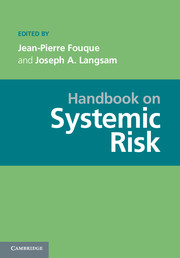Book contents
- Frontmatter
- Contents
- Contributors
- Introduction
- PART I DATA: THE PREREQUISITE FOR MANAGING SYSTEMIC RISK
- PART II STATISTICS AND SYSTEMIC RISK
- PART III MEASURING AND REGULATING SYSTEMIC RISK
- PART IV NETWORKS
- PART V SYSTEMIC RISK ANDMATHEMATICAL FINANCE
- PART VI COUNTERPARTY RISK AND SYSTEMIC RISK
- PART VII ALGORITHMIC TRADING
- PART VIII BEHAVIORAL FINANCE: THE PSYCHOLOGICAL DIMENSION OF SYSTEMIC RISK
- 23 Fear, Greed, and Financial Crises: A Cognitive Neurosciences Perspective
- 24 Bubbles, Crises, and Heterogeneous Beliefs
- 25 Systemic Risk and Sentiment
- PART IX REGULATION
- PART X COMPUTATIONAL ISSUES AND REQUIREMENTS
- PART XI ACCOUNTING ISSUES
- References
25 - Systemic Risk and Sentiment
from PART VIII - BEHAVIORAL FINANCE: THE PSYCHOLOGICAL DIMENSION OF SYSTEMIC RISK
Published online by Cambridge University Press: 05 June 2013
- Frontmatter
- Contents
- Contributors
- Introduction
- PART I DATA: THE PREREQUISITE FOR MANAGING SYSTEMIC RISK
- PART II STATISTICS AND SYSTEMIC RISK
- PART III MEASURING AND REGULATING SYSTEMIC RISK
- PART IV NETWORKS
- PART V SYSTEMIC RISK ANDMATHEMATICAL FINANCE
- PART VI COUNTERPARTY RISK AND SYSTEMIC RISK
- PART VII ALGORITHMIC TRADING
- PART VIII BEHAVIORAL FINANCE: THE PSYCHOLOGICAL DIMENSION OF SYSTEMIC RISK
- 23 Fear, Greed, and Financial Crises: A Cognitive Neurosciences Perspective
- 24 Bubbles, Crises, and Heterogeneous Beliefs
- 25 Systemic Risk and Sentiment
- PART IX REGULATION
- PART X COMPUTATIONAL ISSUES AND REQUIREMENTS
- PART XI ACCOUNTING ISSUES
- References
Summary
Abstract Regulators charged with monitoring systemic risk need to focus on sentiment as well as narrowly defined measures of systemic risk. This chapter describes techniques for jointly monitoring the co-evolution of sentiment and systemic risk. To measure systemic risk, we use Marginal Expected Shortfall. To measure sentiment, we apply a behavioral extension of traditional pricing kernel theory, which we supplement with external proxies. We illustrate the technique by analyzing the dynamics of sentiment before, during, and after the global financial crisis which erupted in September 2008. Using stock and options data for the S&P 500 during the period 2002–2009, our analysis documents the statistical relationship between sentiment and systemic risk.
Keywords Systemic risk, Marginal Expected Shortfall, Pricing Kernel, Overconfidence, Optimism; JEL Codes: E61, G01, G02, G28
Introduction
The report of the Financial Crisis Inquiry Commission (FCIC, 2011) emphasizes the importance of systemic risk and sentiment. These two concepts, and the relationship between them, are important for regulatory bodies such as the Financial Stability Oversight Council (FSOC) who, with the support of the Office of Financial Research (OFR), is charged with the responsibility for monitoring systemic risk throughout the financial system. This chapter describes tools regulators can use to monitor sentiment and its impact on systemic risk.
Information
- Type
- Chapter
- Information
- Handbook on Systemic Risk , pp. 714 - 742Publisher: Cambridge University PressPrint publication year: 2013
References
Accessibility standard: Unknown
Why this information is here
This section outlines the accessibility features of this content - including support for screen readers, full keyboard navigation and high-contrast display options. This may not be relevant for you.Accessibility Information
- 5
- Cited by
